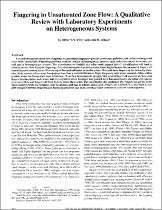 ResearchSpace
ResearchSpace
Fingering in unsaturated zone flow: a qualitative review with laboratory experiments on heterogeneous systems
JavaScript is disabled for your browser. Some features of this site may not work without it.
- ResearchSpace
- →
- Research Publications/Outputs
- →
- Journal Articles
- →
- View Item
| dc.contributor.author |
Sililo, OTN

|
en_US |
| dc.contributor.author |
Tellam, JH

|
en_US |
| dc.date.accessioned | 2007-03-26T07:23:34Z | en_US |
| dc.date.accessioned | 2007-06-07T10:08:14Z | |
| dc.date.available | 2007-03-26T07:23:34Z | en_US |
| dc.date.available | 2007-06-07T10:08:14Z | |
| dc.date.copyright | en_US | |
| dc.date.issued | 2000-11 | en_US |
| dc.identifier.citation | Sililo, OTN and Tellam, JH. 2000. Fingering in unsaturated zone flow: a qualitative review with laboratory experiments on heterogeneous systems. Ground Water, vol. 38(6), pp 864-871 | en_US |
| dc.identifier.issn | 0017-467X | en_US |
| dc.identifier.uri | http://hdl.handle.net/10204/2030 | en_US |
| dc.identifier.uri | http://hdl.handle.net/10204/2030 | |
| dc.description.abstract | Unstable unsaturated zone flow (fingering) is a potentially important process in recharge, pollution, and surface water/ground water body interactions. Extending previous workers ' studies on homogeneous systems, sand tank experiments have been carried out on heterogeneous systems. The experiments on initially dry silica sands suggest that (1) stratification will tend to enhance rather than dissipate fingering; (2) in discontinuously layered systems, funnelling influences the location of fingers; (3) in multilayered systems, lateral flow on top of fine-grained layers promotes greater flux (and more fingers) in the down-dip direction; (4) in systems where a top fine-grained layer has a variable thickness, finger frequency and, hence, amount of flow will be greatest where the fine-grained layer is thinnest; (5) surface depressions in an upper fine-grained layer will concentrate flow, with fingers forming below such areas; and (6) in systems where an upper fine-grained layer has macro pores, the latter will concentrate water flow and fingers will form directly below these zones. The experiments also confirmed that fingers can persist in the same locations from one recharge event to another, and that in initially moist sands, fingers are widened. It is clear that a complex interplay between fingering and funnelling processes can occur and that finger behaviour is sensitive to heterogeneity. | en_US |
| dc.format.extent | 1154963 bytes | en_US |
| dc.format.mimetype | application/pdf | en_US |
| dc.language.iso | en | en_US |
| dc.publisher | Ground Water Publishing Co | en_US |
| dc.rights | Copyright: 2000 Ground Water Publishing Co | en_US |
| dc.source | en_US | |
| dc.subject | Homogeneous systems | en_US |
| dc.subject | Unsaturated zone flow | en_US |
| dc.subject | Funnelling processes | en_US |
| dc.subject | Fingering processes | en_US |
| dc.subject | Water resources | en_US |
| dc.title | Fingering in unsaturated zone flow: a qualitative review with laboratory experiments on heterogeneous systems | en_US |
| dc.type | Article | en_US |
| dc.identifier.apacitation | Sililo, O., & Tellam, J. (2000). Fingering in unsaturated zone flow: a qualitative review with laboratory experiments on heterogeneous systems. http://hdl.handle.net/10204/2030 | en_ZA |
| dc.identifier.chicagocitation | Sililo, OTN, and JH Tellam "Fingering in unsaturated zone flow: a qualitative review with laboratory experiments on heterogeneous systems." (2000) http://hdl.handle.net/10204/2030 | en_ZA |
| dc.identifier.vancouvercitation | Sililo O, Tellam J. Fingering in unsaturated zone flow: a qualitative review with laboratory experiments on heterogeneous systems. 2000; http://hdl.handle.net/10204/2030. | en_ZA |
| dc.identifier.ris | TY - Article AU - Sililo, OTN AU - Tellam, JH AB - Unstable unsaturated zone flow (fingering) is a potentially important process in recharge, pollution, and surface water/ground water body interactions. Extending previous workers ' studies on homogeneous systems, sand tank experiments have been carried out on heterogeneous systems. The experiments on initially dry silica sands suggest that (1) stratification will tend to enhance rather than dissipate fingering; (2) in discontinuously layered systems, funnelling influences the location of fingers; (3) in multilayered systems, lateral flow on top of fine-grained layers promotes greater flux (and more fingers) in the down-dip direction; (4) in systems where a top fine-grained layer has a variable thickness, finger frequency and, hence, amount of flow will be greatest where the fine-grained layer is thinnest; (5) surface depressions in an upper fine-grained layer will concentrate flow, with fingers forming below such areas; and (6) in systems where an upper fine-grained layer has macro pores, the latter will concentrate water flow and fingers will form directly below these zones. The experiments also confirmed that fingers can persist in the same locations from one recharge event to another, and that in initially moist sands, fingers are widened. It is clear that a complex interplay between fingering and funnelling processes can occur and that finger behaviour is sensitive to heterogeneity. DA - 2000-11 DB - ResearchSpace DP - CSIR KW - Homogeneous systems KW - Unsaturated zone flow KW - Funnelling processes KW - Fingering processes KW - Water resources LK - https://researchspace.csir.co.za PY - 2000 SM - 0017-467X T1 - Fingering in unsaturated zone flow: a qualitative review with laboratory experiments on heterogeneous systems TI - Fingering in unsaturated zone flow: a qualitative review with laboratory experiments on heterogeneous systems UR - http://hdl.handle.net/10204/2030 ER - | en_ZA |





